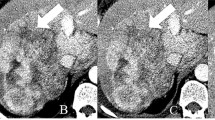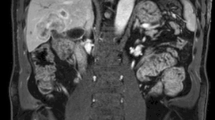Abstract
Cholangiocarcinoma is a relatively uncommon malignant neoplasm with poor prognosis. The distinction between extrahepatic and intrahepatic subtypes is important as epidemiological features, biologic and pathologic characteristics, and clinical course are different for both entities. This review study focuses on the role imaging plays in the diagnosis, classification, staging, and post-treatment assessment of cholangiocarcinoma.




(Image courtesy Dr.Ujwal Bhure)

(Image courtesy Dr.Ujwal Bhure)

(Image courtesy Dr.Ujwal Bhure)


(Image courtesy Dr.Ujwal Bhure)


(Image courtesy Dr.Ujwal Bhure)
Similar content being viewed by others
References
Khan SA, Toledano MB, Taylor-Robinson SD (2008) Epidemiology, risk factors, and pathogenesis of cholangiocarcinoma. HPB 10(2):77–82
Saha SK, Zhu AX, Fuchs CS, Brooks GA (2016) Forty-year trend in cholangiocarcinoma incidence in the U.S.: intrahepatic disease in the rise. The Oncologist 21:594–599
Nakanuma Y, Sato Y, Harada K, et al. (2010) Pathological classification of intrahepatic cholangiocarcinoma based on a new concept. World J Hepatol 2(12):419–427
Yamamoto M, Takasaki K, Yoshikawa T, Ueno K, Nakano M (1998) Does gross appearance indicate prognosis in intrahepatic cholangiocarcinoma? J Surg Oncol 69(3):162–167
Sasaki A, Aramaki M, Kawano K, et al. (1998) Intrahepatic peripheral cholangiocarcinoma: mode of spread and choice of surgical treatment. Br J Surg 85(9):1206–1209
Japan LCSGo (1997) Classification of primary liver cancer. Tokyo: Kanehara
Craig JRPR, Edmonson HA (1989) Tumors of the liver and intrahepatic bile ducts. Atlas of Tumor Pathology: Washington, DC, pp 171–179
Odze RD, Goldblum JR (2014) Odze and Goldblum surgical pathology of the GI tract, liver, biliary tract and pancreas. Berlin: Elsevier Health Sciences
Mounajjed T, Chandan VS, Torbenson MS (2015) Surgical pathology of liver tumors. New York: Springer International Publishing
S-i Aishima, Asayama Y, Taguchi K-i, Sugimachi K, Shirabe K, Shimada M, Sugimachi K, Tsuneyoshi M (2002) The utility of keratin 903 as a new prognostic marker in mass-forming-type intrahepatic cholangiocarcinoma. Mod Pathol 15(11):1181–1190
Lau SK, Prakash S, Geller SA, Alsabeh R (2002) Comparative immunohistochemical profile of hepatocellular carcinoma, cholangiocarcinoma, and metastatic adenocarcinoma. Hum Pathol 33(12):1175–1181. doi:10.1053/hupa.2002.130104
Hamada S, Satoh K, Hirota M, et al. (2011) Calcium-binding protein S100P is a novel diagnostic marker of cholangiocarcinoma. Cancer Sci 102(1):150–156
Kakar S, Gown AM, Goodman ZD, Ferrell LD (2007) Best practices in diagnostic immunohistochemistry: hepatocellular carcinoma versus metastatic neoplasms. Arch Pathol Lab Med 131(11):1648–1654
Nagorney DM, Donohue JH, Farnell MB, Schleck CD, Ilstrup DM (1993) Outcomes after curative resections of cholangiocarcinoma. Arch Surg 128(8):871–878
Edge S, Byrd D, Compton C, et al. (2010) American Joint Committee on Cancer AJCC cancer staging manual. Ann Surg Oncol 17(6):1471–1474
Roayaie S, Guarrera JV, Michele QY, et al. (1998) Aggressive surgical treatment of intrahepatic cholangiocarcinoma: predictors of outcomes. J Am Coll Surg 187(4):365–372
Jiao Y, Pawlik TM, Anders RA, et al. (2013) Exome sequencing identifies frequent inactivating mutations in BAP1, ARID1A and PBRM1 in intrahepatic cholangiocarcinomas. Nat Genet 45(12):1470–1473
Isa T, Tomita S, Nakachi A, et al. (2001) Analysis of microsatellite instability, K-ras gene mutation and p53 protein overexpression in intrahepatic cholangiocarcinoma. Hepato-gastroenterology 49(45):604–608
Borger DR, Tanabe KK, Fan KC, et al. (2012) Frequent mutation of isocitrate dehydrogenase (IDH) 1 and IDH2 in cholangiocarcinoma identified through broad-based tumor genotyping. The Oncologist 17(1):72–79
Churi CR, Shroff R, Wang Y, et al. (2014) Mutation profiling in cholangiocarcinoma: prognostic and therapeutic implications. PLoS ONE 9(12):e115383. doi:10.1371/journal.pone.0115383
Geynisman DM, Catenacci DV (2012) Toward personalized treatment of advanced biliary tract cancers. Discov Med 14(74):41–57
Allen RA, Lisa JR (1949) Combined liver cell and bile duct carcinoma. Am J Pathol 25:647–655
Zhang F, Chen XP, Zhang W, et al. (2008) COmbined Heaptocellular cholangiocarcinoma originating from hepatic progenitor cells: immunohistochecmical and double-fluorescence immunostaining evidence. Histopathology 52(2):224–232
The Liver Cancer Study Group of Japan (1989) The general rules for the clinical and pathological study of primary lliver cancer. Jpn J Surg 19:98–129
Fowler KJ, Sheybani A, Parker RA III, et al. (2013) Combined hepatocellular and cholangiocarcinoma (Biphenotypic) tumors: imaging features and diagnostic accuracy of contrast-enhanced CT and MRI. AJR 201:332–339
Edmonson HA, Washington DC, Clemett AR. Tumors of the liver and intrahepatic bile ducts: atlas of tumor pathology, sec 7, fasc. 25 Armed Forces Institute of Pathology,. [Cross Reference] Carcinoma of the major bile ducts2000. 894-903 p.
Clemett AR (1965) Carcinoma of the major bile ducts. Radiology 84:894–903. doi:10.1148/84.5.894
Blechacz B, Komuta M, Roskams T, Gores GJ (2011) Clinical Diagnosis and Staging of Cholangiocarcinoma. Nat Rev Gastroenterol Hepatol 8(9):512–522
Farges O, Fuks D, Le Treut YP, et al. (2011) AJCC 7th edition of TNM staging accurately discriminates outcomes of patients with resectable intrahepatic cholangiocarcinoma. Cancer 117:2170–2177
Yamasaki S (2003) Intrahepatic cholangiocarcinoma: macroscopyc type and stage classification. J Hepatobiliary Pancreat Surg 10(4):288–291
DeOliveira ML, Cunningham SC, Cameron JL, et al. (2007) Cholangiocarcinoma: thirty-one-year experience with 564 patients at a single institution. Ann Surg 245(5):755–762
Khan SA, Davidson BR, Goldin RD, et al. (2012) Guidelines for the diagnosis and treatment of cholangiocarcinoma: an update. Gut 61(12):1657–1669
Tsao JI, Nimura Y, Kamiya J, et al. (2000) Management of hilar cholangiocarcinoma: comparison of an American and a Japanese experience. Ann Surg 232(2):166–174
van Gulik TM, Gouma DJ (2007) Changing perspectives in the assessment of resectability of hilar cholangiocarcinoma. Ann Surg Oncol. 14(7):1969–1971. doi:10.1245/s10434-007-9394-8
Lee HY, Kim SH, Lee JM, et al. (2006) Preoperative assessment of resectability of hepatic hilar cholangiocarcinoma: combined CT and cholangiography with revised criteria. Radiology. 239(1):113–121
Hong SM, Presley AE, Stelow EB, Frierson HF Jr, Moskaluk CA (2006) Reconsideration of the histologic definitions used in the pathologic staging of extrahepatic bile duct carcinoma. Am J Surg Pathol. 30(6):744–749
Hong SM, Kang GH, Lee HY, Ro JY, Nishi M, Omori Y, Okabayashi T, Yamamoto J, Kosuge T, Shimada K, Yamasaki S, Takayama T, Makuuchi M. Smooth muscle distribution in the extrahepatic bile duct: histologic and immunohistochemical studies of 122 cases. Am Pathol 24 Cross ref Miwa Research Society for Gastric Cancer JRSGC Japanese classification of gastric carcinoma Kanehara Tokyo Cross ref A new staging system for massforming intrahepatic cholangiocarcinoma analysis of preoperative and postoperative variables Cancer 23742383. 2001;92(9 SRC— GoogleScholar):660–7
Jarnagin WR, Fong Y, DeMatteo RP, et al. (2001) Staging, resectability, and outcome in 225 patients with hilar cholangiocarcinoma. Ann Surg 234(4):507–517
Honickman SP, Mueller PR, Wittenberg J, et al. (1983) Ultrasound in obstructive jaundice: prospective evaluation of site and cause. Radiology 147(2):511–515
Neumaier CE, Bertolotto M, Perrone R, et al. (1995) Staging of hilar cholangiocarcinoma with ultrasound. J Clin Ultrasound 23(3):173–178
Eloubeidi MA, Chen VK, Jhala NC, et al. (2004) Endoscopic ultrasound-guided fine needle aspiration biopsy of suspected cholangiocarcinoma. Clin Gastroenterol Hepatol 2(3):209–213
Zandrino F, Benzi L, Ferretti ML, et al. (2002) Multislice CT cholangiography without biliary contrast agent: technique and initial clinical results in the assessment of patients with biliary obstruction. Eur Radiol 12(5):1155–1161
Ahmetoglu A, Kosucu P, Kul S, et al. (2004) MDCT cholangiography with volume rendering for the assessment of patients with biliary obstruction. Am J Roentgenol 183(5):1327–1332
Yoon HJ, Kim YK, Jang KT, et al. (2013) Intraductal papillary neoplasm of the bile ducts: description of MRI and added value of diffusion-weighted MRI. Abdom Imaging 38(5):1082–1090
Lee NK, Kim S, Kim GH, et al. (2012) Diffusion-weighted imaging of biliopancreatic disorders: correlation with conventional magnetic resonance imaging. World J Gastroenterol 18(31):4102–4117. doi:10.3748/wjg.v18.i31.4102
Kim JY, Kim MH, Lee TY, et al. (2008) Clinical role of 18F-FDG PET-CT in suspected and potentially operable cholangiocarcinoma: a prospective study compared with conventional imaging. Am J Gastroenterol 103(5):1145–1151. doi:10.1111/j.1572-0241.2007.01710.x
Petrowsky H, Wildbrett P, Husarik DB, et al. (2006) Impact of integrated positron emission tomography and computed tomography on staging and management of gallbladder cancer and cholangiocarcinoma. J Hepatol 45(1):43–50. doi:10.1016/j.jhep.2006.03.009
Breitenstein S, Apestegui C, Clavien PA (2008) Positron emission tomography (PET) for Cholangiocarcinoma. HPB 10(2):120–121
Jadvar H, Henderson RW, Conti PS (2007) [F-18]fluorodeoxyglucose positron emission tomography and positron emission tomography: computed tomography in recurrent and metastatic cholangiocarcinoma. J Comput Assist Tomogr 31(2):223–228. doi:10.1097/01.rct.0000237811.88251.d7
Kluge R, Schmidt F, Caca K, et al. (2001) Positron emission tomography with [(18)F]fluoro-2-deoxy-d-glucose for diagnosis and staging of bile duct cancer. Hepatology 33(5):1029–1035. doi:10.1053/jhep.2001.23912
Seo S, Hatano E, Higashi T, et al. (2008) Fluorine-18 fluorodeoxyglucose positron emission tomography predicts lymph node metastasis, P-glycoprotein expression, and recurrence after resection in mass-forming intrahepatic cholangiocarcinoma. Surgery 143(6):769–777. doi:10.1016/j.surg.2008.01.010
Chung YE, Kim MJ, Park YN, et al. (2009) Varying appearances of cholangiocarcinoma: radiologic-pathologic correlation. Radiographics 29(3):683–700. doi:10.1148/rg.293085729
Wernecke K, Henke L, Vassallo P, et al. (1992) Pathologic explanation for hypoechoic halo seen on sonograms of malignant liver tumors: an in vitro correlative study. AJR Am J Roentgenol 159(5):1011–1016
Yoshida Y, Imai Y, Murakami T, et al. (1999) Intrahepatic cholangiocarcinoma with marked hypervascularity. Abdom Imaging 24(1):66–68
Nakanuma Y (2010) A novel approach to biliary tract pathology based on similarities to pancreatic counterparts: is the biliary tract an incomplete pancreas? Pathol Int 60(6):419–429
Nakanuma Y, Harada K, Sasaki M, Sato Y (2014) Proposal of a new disease concept “biliary diseases with pancreatic counterparts”. Anatomical and pathological bases. Histol Histopathol 29(1):1–10
Kawakatsu M, Vilgrain V, Zins M, et al. (1997) Radiologic features of papillary adenoma and papillomatosis of the biliary tract. Abdom Imaging 22(1):87–90
Gonda TA, Glick MP, Sethi A, et al. (2012) Polysomy and p16 deletion by fluorescence in situ hybridization in the diagnosis of indeterminate biliary strictures. Gastrointest Endosc 75(1):74–79
Deshpande V, Konstantinidis IT, Castillo CF, et al. (2016) Intra-pancreatic distal bile duct carcinoma is morphologically, genetically, and clinically distinct from pancreatic ductal adenocarcinoma. J Gastrointest Surg . doi:10.1007/s11605-016-3108-0
Poggi G, Amatu A, Montagna B, et al. (2009) OEM-TACE: a new therapeutic approach in unresectable intrahepatic cholangiocarcinoma. Cardiovasc Interv Radiol 32(6):1187–1192
Ruys AT, van Haelst S, Busch OR, et al. (2012) Long-term survival in hilar cholangiocarcinoma also possible in unresectable patients. World J Surg 36:2179–2186
Tan JCC, Coburn NG, Baxter NN, Kiss A, Law CHL (2008) Surgical management of intrahepatic cholangiocarcinoma–a population-based study. Ann Surg Oncol 15(2):600–608
Shaib YH, Davila JA, Henderson L, McGlynn KA, El-Serag HB (2007) Endoscopic and surgical therapy for intrahepatic cholangiocarcinoma in the united states: a population-based study. J Clin Gastroenterol 41(10):911–917
Nakeeb A, Tran KQ, Black MJ, et al. (2002) Improved survival in resected biliary malignancies. Surgery 132(4):555–563 (discission 63)
Meyer CG, Penn I, James L (2000) Liver transplantation for cholangiocarcinoma: results in 207 patients. Transplantation 69(8):1633–1637
De Vreede I, Steers JL, Burch PA, et al. (2000) Prolonged disease-free survival after orthotopic liver transplantation plus adjuvant chemoirradiation for cholangiocarcinoma. Liver Transplant 6(3):309–316
Thongprasert S (2005) The role of chemotherapy in cholangiocarcinoma. Ann Oncol 16(Suppl 2):93–96
Vauthey JN, Blumgart LH (1994) Recent advances in the management of cholangiocarcinomas. Semin Liver Dis 14(2):109–114
Chari RS, Rose BD, Wellesley MA. Treatment of cholangiocarcinoma II 2003.
Acknowledgements
Aoife Kilcoyne would like to acknowledge the support of the Mac Erlaine Scholarship, from the Academic Radiology Research Trust, St. Vincent’s Radiology Group, Dublin, Ireland. Irai S Oliveira would like to acknowledge the support from Hospital Sírio-Libanês, São Paulo, Brazil.
Author information
Authors and Affiliations
Corresponding author
Ethics declarations
Funding
No funding was received for this study.
Conflict of interest
The authors declare that they have no conflict of interest.
Ethical approval
All procedures performed in studies involving human participants were in accordance with the ethical standards of the institutional and/or national research committee and with the 1964 Helsinki declaration and its later amendments or comparable ethical standards. This article does not contain any studies with animals performed by any of the authors. For this type of study formal consent is not required.
Informed consent
Statement of informed consent was not applicable since the manuscript does not contain any patient data.
Additional information
CME activity
This article has been selected as the CME activity for the current month. Please visit https://ce.mayo.edu/node/44446 and follow the instructions to complete this CME activity.
Rights and permissions
About this article
Cite this article
Oliveira, I.S., Kilcoyne, A., Everett, J.M. et al. Cholangiocarcinoma: classification, diagnosis, staging, imaging features, and management. Abdom Radiol 42, 1637–1649 (2017). https://doi.org/10.1007/s00261-017-1094-7
Published:
Issue Date:
DOI: https://doi.org/10.1007/s00261-017-1094-7




